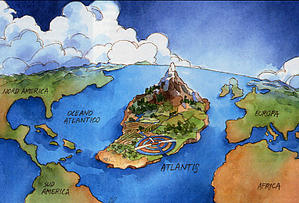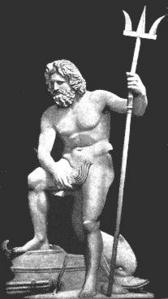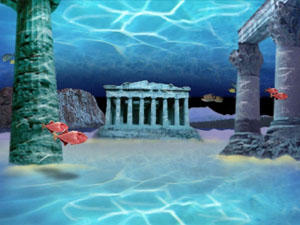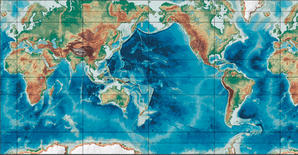With this new chapter we continue our approach of the lost continent with scientific discoveries which in recent years have provided some disturbing information. Each reader can then do the needed synthesis for a better comprehension.
Unexpected discoveries
Scientists, at the beginning of the 20th century, refrained from considering theories when facts pertaining to this sunken area were again brought to light. A German Atlantologist, Jürgen Spanuth, refused to accept these revelations. In his opinion the last Atlantic collapses date back millions of years, which would exclude the presence of Man. His assertions are not at all based in fact for although this German pastor made his contribution in the long history of the search of the sunken continent he certainly was not interested in the discoveries made a few decades ago by a former president of the Prehistoric Society of France, Georges Poisson, who exposed the work of a renowned geologist: Pierre Termier. The research of this last led him to reveal that during the laying of a submarine cable linking Brest to Cape Cod in 1908,at the North of the Azores, at 47 ° N and 19 ° 40’ W, and 500 miles from the Islands, the pitchfork brought back small mineral splinters having the appearance of recently broken shards.
 On this subject Pierre Termier commented:
On this subject Pierre Termier commented:
The splinters thus pulled from rocky outcrops at the bottom of the Atlantic are of vitreous lava… Such lava, completely vitreous, reaches this state only under atmospheric pressure. Moreover, these summits must have collapsed suddenly in a relatively recent epoch; otherwise the atmospheric erosion and marine abrasion would have long leveled the entire surface.
This scientist’s conclusion deserves our attention:
A whole region North of the Azores, perhaps including the Azores themselves – and in this case these islands would only be the visible ruins- collapsed quite recently, probably during what geologists name the “present” epoch, so much that is recent, and which, to us in this day, seems like yesterday.
Georges Poisson, meanwhile, gives the approximate dates of this collapse. He thinks it could date back to the time of the withdrawal of the ice, that is, between 18,500 and 6500 B.C. It should be noted that Plato placed this cataclysm in 9600 B.C. The two dates seem to be perfectly compatible.
When considering the current depths of the Atlantic one realizes that a very particular geographical relief takes shape. The seabed is truly crossed by mountain chains roughly parallel to the East and West coasts. The North Atlantic chain begins at the foot of Spitsbergen, contours the coast of Greenland, widens around Iceland and expands around the dome of the Azores. It stops right before the equator. Then, there is an isolated massif, the equatorial massif, followed by a South Atlantic chain that extends to Tristan da Cunha Island and runs east to Bouvet Island.

There is still another important observation here: these North-South chains are regularly crossed by East-West transversal chains linking Iceland to Greenland, Iceland, England and Cape Cod to Cape St Vincent, Puerto Rico to the Strait of Gibraltar, and Cape San Roque in Brazil to the African coast of Guinea. When geologists discovered these cross-chains, they immediately put forward the theory of “bridges”.
These chains would be debris from strips of land between the two shores of the ocean; these would have collapsed during the Quaternary, which would support other discoveries we will now discuss.
When a discovery is made, a chain reaction ensues. Thus, with the so-called theory of “bridges” biologists themselves have reached interesting conclusions. On both sides of the Atlantic there is a similar fauna and flora whereas such is not the case for other continents. And this is indisputable for Tertiary and Quaternary species.
The phenomenon of eels
The philosopher Aristotle was the first to be interested in the eels but because of a lack of resources he could not go very far in his investigations. It was only in 1922 that Schmidt, the Danish scientist, observed the multiplication of the eels; after months of studying their evolution, he then reached convincing results. It turned out that only the females live in the rivers and ponds of Europe, and they stay there for only two years. After that time, they begin to move in other directions, to the mouths of the rivers where the males are awaiting.
Together, the group swims West at great depth. The journey lasts 140 days. Finally, the eels reach the Sargasso Sea near Bermuda. You should know that this sea is cluttered with interlaced marine plants that do not facilitate the navigation of small ships.
Eels begin their spawning at 300 meters below level in the Sargasso Sea. Then the females die and very early small eels leave for Europe. Sailors know this because they swim in huge shoals of up to 25 meters thick for three years. At the mouths of rivers the males remain at sea and the females go upstream. Two years later the cycle will resume.
It was colonel Braghine who reported this, and he was able to deduce:
At some time, a continent with a great river existed between Europe and the Bermudas. Perhaps the Sargasso Sea is the survival of the swampy delta of this giant prehistoric river and eels, accustomed during millions of years to spawn there in safety from their enemies, have preserved this habit until to-day, when not only the river, but the continent itself has disappeared.
The collapse of the Atlantean plate had multiple consequences. One of the most important was that it allowed the Gulf Stream to course to the European coasts, freeing them of their ice cap. This, in a way, explains the local end of the last glaciation. We must now clarify this hypothesis and confront the two theories that currently differ over the real causes of the disappearance of Atlantis.
The geophysical phenomenon
Evidence concerning Atlantis, you have understood, is not much, but it is sufficient enough to support a viable conclusion. What is important in such cases is to do inferential investigations and comparisons of recent scientific data.
During the last 10,000 years, as a result of the melting of the continental ice in North America, Northern and Central Europe, the level of the seas and oceans rose substantially, and this increase could have been at the origin (a cause only) of the collapse of Atlantis. But we will go further.
According to the American anthropologist Alan H. Kelso de Montigny the map of the Atlantic seabed shows an impressive “hole” right in the middle of the arch of the West Indies, which surrounds it like the remnant of a giant crater half submerged. Kelso de Montigny is of the opinion that at this particular point a planetoid must have struck about 10,000 years ago.
We reach here a most alluring theory as we think of the goddess with the mane of fire, the sky that is set ablaze, etc., in the various traditions that we have examined together. This is a non-negligible constant, and we enjoin you to review these ancient texts for the explanations that follow, when it comes to the rain of hot water, rain of fire, rain of tar, etc…
As regards the planetoid, it could have been a fragment of a heavenly body that caused this cataclysm. When considering these facts, one comes to think that the two underwater cavities at the center of the disaster are due to the impact of the nucleus of the planetoid, split in two pieces. Recent scientific discoveries tend to prove that this cataclysm really took place at the heart of the Atlantic Ocean several thousand years ago.
The fall of the planetoid, according to author Otto Muck, would have caused chain reactions that are easy to observe thanks to geological deposits still visible nowadays. He said:
If we take a total of 2 x 1016 tonnes of water mixed with 3x 1015 tonnes of ash and spread evenly across the whole of northern Eurasia, this will yield a mean depth of rain of about 100 feet (30 meters). This was the immense reservoir out of which the downpour burst on the old world. The floodgates of heaven were truly opened. Springs, small streams, great rivers- all swelled under the tremendous cloud-bursts…The erupting gases included, in addition to water vapor, carbon dioxide and other asphyxiating gases such as sulfurous vapors and hydrogen sulfide, chloride and the other highly volatile compounds.
But in the liquid magma there also had to be non-combustible gases. It follows that during the catastrophe on Atlantis, an enormous amount of choking gas was released and that must have had disastrous effects upon human beings. Perhaps it was not the Flood itself that caused the fall of Atlantis; it was only the immediate consequence.
This rain of stones, gases and solids, had to generate 1.5 billion tons of pumice, i.e., a mass of 3 million km3. Consequently, this had to form a layer of about one hundred meters upon the ocean. According to estimated calculations, this “sea of mud”, as called in some ancient writings, would have remained there for about three thousand years, which made navigation impossible. And one can read how many ships ventured in vain to this area…
Otto Muck’s conclusions are directly connected to the discoveries made by other researchers who are Atlantologists or specialists in other disciplines.
Nevertheless, it should be noted that the ancient texts are seen in a new light thanks to Muck’s conclusions. There is a constant, and we have seen it in these writings of the chroniclers of the past: it is this fire that falls from the sky, this sudden night that appears. However, we now know a little better how this cataclysm could have occurred and the disastrous effects it must have had on human beings about 12,000 years ago. Some populations had to be decimated; animals, flora, everything had to start from scratch, almost in all areas.
 That is why caves and mountains were the only refuges for those who wanted to escape this disaster. Also, it must be said that the gases that we mentioned certainly had to damage what prevents ultraviolet rays from burning life on Earth, i.e.,the protective ozone layer at high altitude. For several centuries life must have been very hard, and the custodians of knowledge, knowing that this cataclysm was coming, received the mission of safeguarding the human heritage in secret locations. That is why one can find some anachronisms in the history reported by chroniclers such as weapons of fire in remote times or men manipulating electricity.
That is why caves and mountains were the only refuges for those who wanted to escape this disaster. Also, it must be said that the gases that we mentioned certainly had to damage what prevents ultraviolet rays from burning life on Earth, i.e.,the protective ozone layer at high altitude. For several centuries life must have been very hard, and the custodians of knowledge, knowing that this cataclysm was coming, received the mission of safeguarding the human heritage in secret locations. That is why one can find some anachronisms in the history reported by chroniclers such as weapons of fire in remote times or men manipulating electricity.
As the planet must have suffered a big shock it was certainly not possible to keep all the technology and the science of their forefathers. However, it is interesting to note how the heirs of the Atlanteans were able to create some extraordinary civilizations after the Flood. The survivors of the Flood – 12,000 years ago- had already lost a large part of their scientific knowledge. The Wise Men who would form what is now known as the Great white Lodge had already taken the necessary measures to protect the Tradition so as to initiate the new cycle of evolution that was to begin on Earth. A new type of human beings was to come… (See my book : The atlantean choice, by Guillaume Delaage).
To conclude
Here ends this study of the lost continent. We could have discussed new scientific research and discoveries made recently by scientists that indicate that a continent did exist beyond the Strait of Gibraltar. Although timid in their conclusions these researchers attest to the existence of these lands which for a long time were considered mythical. An article published in 2001 in Research, a scientific magazine, confirms the reality of lands that would confirm Plato’s account. This revenge of the myth on science is just in its infancy with regard to what remains to be discovered and all that will never be. Atlantis is part of our past and our origins.
Today, as the world shudders with fear because of the folly of some, it is time to ponder our future. A question that was not really raised in the context of these various articles is: what do we have to learn from all this? Why was Atlantis sunken? Tradition says that the Atlanteans once became wicked and shadowy. Their pride led them to their decline and the cataclysm. Powers were used for selfish and destructive ends. They made their fellow men and the planet suffer, and their world was destroyed.
One does not have to be a seer to notice that nowadays the scenario appears to be the same, although we cannot quite compare that era to ours. However, many things seem identical. Under the laws of Karma, we have not finished paying the Atlantean debt. That is why, today, two paths open before us: we either decide to open up and respond to the awakening of consciousness or we sink in the search of the instant gratification which satisfies the ego.
With the first perspective, we have everything to gain. With the second, we open a door leading to an unfathomable abyss which no one knows what kind of disaster it can lead our generation and the ones to follow. That is the choice before our Humanity. Never have scientists and policymakers spoken with so much insistence about the risks to our planet; never has the technology been so powerful to drive Man to self-destroy. In my book:
“LE CHOIX ATLANTE
Ou l’origine du mal planetaire actuel”
I discuss in details all these subjects and an Atlantis even older than what is referred to in the different articles.
This speech is not meant to be catastrophic. On the contrary, it seeks to demonstrate that everyone has the free will to take the path of life and evolution, with consciousness and steadfastness, and side with wisdom. Great beings have come over the past century to bring a message of hope by opening the doors of Knowledge to all, which had never happened before.
These things do not happen without a reason.

